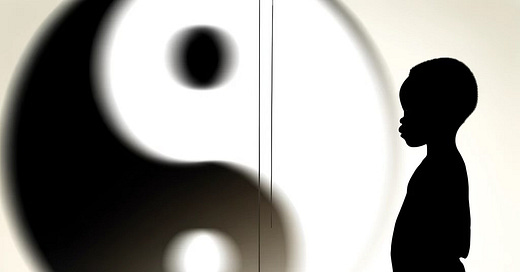As a child growing up in Columbus, Ohio, my world was a tapestry woven with wonder and simplicity. The Center of Science and Industry (COSI) was a gateway to the universe of science and nature.
It's in this haven of learning where I first encountered the workings of a giant pendulum. Suspended from the ceiling, it swung rhythmically, knocking over pins arrayed in a circle, a mesmerizing dance of precision and grace in front of visitors to the center. This pendulum, an emblem of my childhood fascination, now strikes me as a profound metaphor for the Taoist concept of polarity, specifically the concepts of yin and yang.
Taoism, an ancient Chinese philosophy, perceives existence as a harmonious balance of opposites. The yin and yang, fundamental to this worldview, are not merely opposing forces; they are complementary, interdependent elements that give rise to each other as they interrelate to one another.
The pendulum's motion encapsulates this idea: as it swings (yang), it inevitably returns (yin), in an endless, fluid motion. Each movement gives rise to the other, just as day turns into night, and winter succumbs to spring.
In my reflections, I often see the manifestations of yin and yang in our contemporary world. Consider the polarities in politics – parties often positioned in opposition, yet each defining itself through its contrast with the other.
This is the essence of Taoist polarity: without one, the other loses its context and meaning. In a deeper sense, this interplay reminds us that opposing forces are essential for the existence and understanding of each other, rather than being merely conflicting entities.
Growing up, I began to observe the reciprocal relationship of yin and yang in everyday life. I noticed how the strength of one aspect often depends on the weakness of its counterpart. For instance, in moments of silence (yin), the value of speech (yang) becomes apparent, and in times of chaos (yang), the peace of stillness (yin) is deeply desired. This interdependence is not a battle for dominance but a delicate dance of balance and harmony.
This concept is not limited to grand philosophical ideas but permeates the minutiae of daily life. In personal relationships, for instance, the assertiveness of one person (yang) is often balanced by the receptiveness of another (yin). In nature, the fierce blaze of the sun (yang) is tempered by the coolness of the moon (yin).
Even in our own bodies, the physical strength (yang) is balanced by emotional intuition (yin). Each aspect, in its essence, contains a trace of its opposite, symbolizing the interconnectedness and impermanence of all things.
Reflecting on the Taoist view of polarity, I am constantly reminded that life is not about choosing sides but understanding and embracing the complementary nature of all experiences. It's about recognizing that each moment, each experience, holds within it the seed of its opposite. This realization brings a profound sense of harmony and acceptance of the ebb and flow of life.
In closing, a saying by the ancient philosopher Lao Tzu encapsulates the essence of this theme:
“When people see some things as beautiful, other things become ugly. When people see some things as good, other things become bad."
This profound statement echoes the Taoist appreciation for the balance of opposites, reminding us that the existence of anything is only possible through its contrast with its opposite. As I look back at the pendulum in COSI, I see more than a childhood memory; I see a symbol of life’s intricate balance, a dance of yin and yang, forever in motion, forever interdependent.
The Chocolate Taoist is a reader-supported publication. To receive weekly reflections and support the world of independent publishing, please consider becoming a paid subscriber at $6.00/month or $60.00/year.






Griffith Observatory had a similar pendulum near the entrance the year we lived in Los Angeles when I was 6. I hadn’t thought of it in years. Thanks for bringing that memory to the surface.
Also, the word I have chosen to focus on for 2024 is balance, so several of your recent posts have offered excellent food for thought related to this theme, including this one.
Columbus COSI was an awesome place!